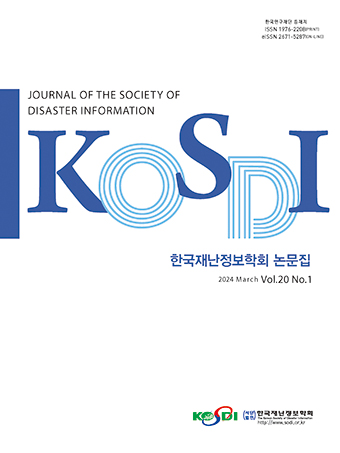Original Article
Abstract
References
Information
Purpose: This study aims to derive a PGV prediction equation and to enhance the application of the Onsite EEW technology which has developed through previous studies. Method: The prediction equation for the Onsite EEW derived from earthquake data M≥3.0 and MMI≥II over the past four years. Local seismic risk is estimated using M and PGV deduced from P wave properties. Result: The improved PGV prediction equation estimated the MMI with an average accuracy of 94.8% and the τc : Pd method also showed valid performance for alerting local seismic risks. Conclusion: Onsite EEW technology is successfully applied to Korea, and becomes to reduce the blind zone to about 14km.
연구목적: 본 연구는 기존 지진현장경보 연구를 통해 단일 지진계에서 관측한 P파로부터 PGV 값을 예측하기 위한 예측식을 제시하고, 예측 결과를 현장경보에 이용하기 위한 기술적 접근 방안들을 도출하기 위한 것이다. 연구방법: 과거 4년간 규모 3,0 이상의 지진가운데 진도등급 II 이상의 데이터를 이용하여 P파로부터 PGV를 예측하기 위한 수식을 도출하고, 진원 정보 추정 없이 지진의 규모와 PGV의 크기를 상대적으로 비교하여 지진위험을 알려줄 수 있는 기술을 적용하였다. 연구결과: 개선한 PGV 예측식은 평균 94.8%의 정확도로 MMI를 추정하였고, τc : Pd 방법 역시 로컬 지진위험을 경보하기 위한 유효한 성과를 보여주었다. 결론: 현장경보기술을 국내에 성공적으로 적용하였으며, 경보공백역을 약 14km 까지 줄일 수 있는 방안을 제시하였다.
- Caruso, A., Colombelli, S., Elia L., Picozzi M., Zollo A. (2017). "An on-site alert level early warning system for Italy." Journal of Geophysical Research: Solid Earth, Vol. 122, pp. 2106-2118, doi:10.1002/2016JB013403. 10.1002/2016JB013403
- Colombelli, S., Caruso, A., Zollo, A., Festa, G., Kanamori, H. (2015). "A P wave-based, on-site method for earthquake early warning." Geophysical Research Letters, Vol. 42, No. 5, pp. 1390-1398. 10.1002/2014GL063002
- Hwang, E.H. (2018). "Analytical performance and realtime operation result of earthquake early warning system in Korea." Proceeding of International Seminar on Earthquake Policy Development, pp.229-241.
- Jennifer, A.S., Richard, M.A. (2016). "Benefits and costs of earthquake early warning." Seismological Research Letters, Vol. 87, No. 3, pp.765-772, doi: 10.1785/0220150149. 10.1785/0220150149
- Kanamori, H. (2005). "Real-time seismology and earthquake damage mitigation." Annual Review of Earth and Planetary Sciences, Vol. 33, pp. 195-214. 10.1146/annurev.earth.33.092203.122626
- Lee, H.J., Jeon, I., Seo, J.B., Lee, J.K. (2018). "Application of the onsite earthquake early warning technology using the seismic P-wave in Korea." Journal of the Society of Disaster Information, Vol. 14, No. 4, pp. 440-449. doi: 10.15683/kosdi.2018.12.31.440. 10.15683/kosdi.2018.12.31.440
- Lee, H.J., Jeon, I, Seo, J.B., Lee, J.K. (2020). "Application of the onsite EEW technology using the P-wave of seismic records in Korea." Journal of the Society of Disaster Information, Vol. 16, No. 1, pp. 133-143, doi: 10. 15683/kosdi.2020.3.31.133. 10. 15683/kosdi.2020.3.31.133
- Lin, P.-Y. (2019). "A successful approach to earthquake early warning systems." Impact, Vol. 2019, No. 9, pp. 18-20. 10.21820/23987073.2019.9.18
- Lomax, A., Satriano, C., Vassallo, M. (2012). "Automatic picker developments and optimization: Filterpicker - a robust, broadband picker for real - time seismic monitoring and earthquake early warning." Seismological Research Letters, Vol. 83, No. 3, pp. 531-540, doi: 10.1785/gssrl.83.3.531. 10.1785/gssrl.83.3.531
- Meguro, K., Fujinawa, Y. (2007). Earthquake Early Warning. Todai Seisan Gijutu Institute, Japan.
- Ministry of Public Safety and Security (2017). Common Application of Seismic Design Standards, Korea.
- Ross, Z.E., Meier, M.A., Hauksson, E., Heaton, T.H. (2018). "Generalized seismic phase detection with deep learning." Bulletin of the Seismological Society of America, Vol. 108, No. 5A, pp. 2894-2901. 10.1785/0120180080
- Seo, J.B. (2020). "Status and prospects of onsite earthquake early warning using machine learning." Information & Communications Magazine, Vol. 37, No. 4, pp. 46-53.
- Wu, B.R., Hsiao, N.C., Lin, P.Y., Hsu, T.Y., Chen, C.Y., Huang, S.K., Chiang, H.W. (2017). "An integrated earthquake early warning system and its performance at schools in Taiwan" Journal of Seismology, Vol. 21, pp. 165-180, doi: 10.1007/s10950-016-9595-3. 10.1007/s10950-016-9595-3
- Wu, Y.M., Kanamori, H. (2005). "Experiment on an onsite early warning method for the Taiwan early warning system." Bulletin of the Seismological Society of America, Vol. 95, No. 1, pp. 347-353. 10.1785/0120040097
- Wu, Y.M., Kanamori, H. (2008). "Development of an earthquake early warning system using real-time strong motion signals." Sensors, Vol. 8, pp.1-9. 10.3390/s8010001 27879692 PMC3681156
- Wu, Y.M., Shieh, J.T., Huang, W.T., Zhao, W.A. (2008). Development of earthquake early warning system using initial P waves (II), Department of Geosciences, National Taiwan University, RG9902-0123, Central Weather Bureau, Taiwan.
- Youn, S.M. (2020). "The impact of the government's earthquake disaster response capabilities and the legal and institutional appropriateness of the disaster management system on the operational performance of disaster management : Focused on fire officer's consciousness." Journal of the Society of Disaster Information, Vol.16, No. 2, pp. 318-330.
- Zhu, W., Beroza, G.C. (2019). "Phasenet: A deep-neural-network-based seismic arrival-time picking method." Geophysical Journal International, Vol. 216, No. 1, pp. 261-273. 10.1093/gji/ggy423
- Publisher :The Korean Society of Disaster Information
- Publisher(Ko) :한국재난정보학회
- Journal Title :Journal of the Society of Disaster Information
- Journal Title(Ko) :한국재난정보학회논문집
- Volume : 16
- No :4
- Pages :670-681
- DOI :https://doi.org/10.15683/kosdi.2020.12.31.670




 Journal of the Society of Disaster Information
Journal of the Society of Disaster Information







